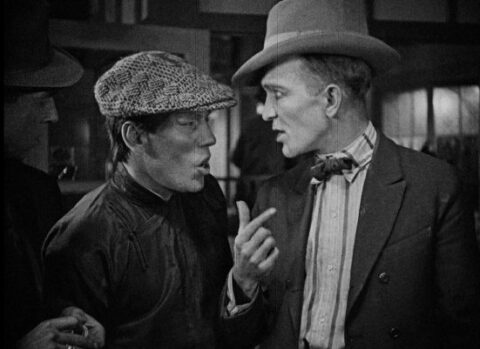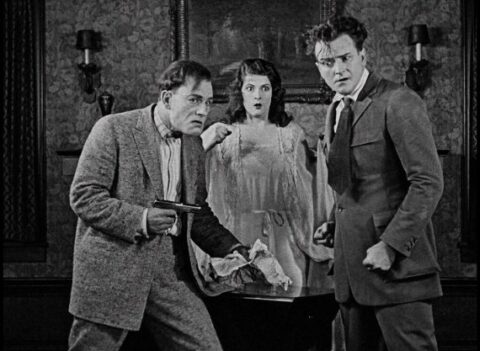Outside The Law (1920)
Directed by: Tod Browning
Written by: Lucien Hubbard, Tod Browning
Starring: Lon Chaney, Priscilla Dean, Ralph Lewis, Wheeler Oakman
USA
AVAILABLE ON BLU-RAY: 13TH JUNE 2022 from EUREKA ENTERTAINMENT
RUNNING TIME: 76 mins
REVIEWED BY: Dr Lenera

Silent Madden, a criminal leader in San Francisco, and his gangster daughter Molly have forsaken a life of crime due to receiving counsel from Chang Lo, a Confucianist philosopher living in Chinatown. However, when vile gangster “Blackie” aka Black Mike Sylva frames Molly’s father for murder, the angry and upset Molly loses faith in abiding by the law and decides to return to a life of crime. She gets involved in plans to rob some jewels at a party and involved in a different way with crook “Dapper” Bill Ballard, not knowing that Blackie is out to frame her just like her father….

It’s a nice notion – that having the right leaders will wash away crime. And unfortunately, not a realistic one – there will always be villainy no matter what. But Confucius tended to get it right more often than he got it wrong, and even then he usually gets us to think. Confucian philosophy, or at least some of the most easily digested of it, explicitly shapes Outside The Law [which is no relation to later films which have that title except for one direct remake], a rare film that depicted Asian characters positively in a period which tended not to do so, even though the following decade did see the creation of two franchises which featured Oriental detectives though of course not Oriental actors. Its combination of blazing action and didactic sentimentality was a common one in its time, many films following a formula and presenting the same messages, though if you think about it that’s not that different from the cinema of today, at least the very commercial kind. For modern viewers, the nature of these tales can often seem very corny, but sometimes the formula can result in something of a strange kind of purity which genuinely touches. This film is sometimes very contrived and seems to rush through parts of its story, especially when changes are taking place in characters which lessens our believability in what we’re watching, but is never dull, has some lovely moments, contains some layered characterisation, has a strong, earthy heroine, and presents The Man Of A Thousand Faces in two early roles for the price of one, one good and one bad – and when I say bad I mean bad. Soon after this, with the same director Tod Browning at the hem, he would often play characters who had a quality of redemption or sadness to them that was relatable despite the ugliness of both their looks and their actions, and this was one of the reasons he became such a star who still fascinates many. However, Blackie is despicable all the way through, at least in this first version of a film which was later re-cut.
This was Browning’s second collaboration with Chaney, though Priscilla Dean, who made nine films with Browning, was really the star. She often played heroines who were tougher than was the norm at the time. Assistant Director Leo McCarey reminisced “Browning was ill so the studio sent me over to direct Chaney. At night a thousand people gathered in the street to watch me direct him. I walked back and forth like a little DeMille. I went over and said “Lon, at least give the appearance of listening to me” but he knew exactly what to do. I gave the appearance of directing him for three nights in a row and made a big impression on the crowds”. The initial 1920 release was a moderate success. By 1926 Browning and Chaney were enjoying considerable success at MGM, so Universal decided to release the film, and got Paul Leni to re-edit it. The exact running time of this cut isn’t clear, but a lot of alternate takes were used and some of Chaney’s scenes as Ah Wing were removed, which is odd really. Perhaps most notably, the entire final action sequence was deleted, making the central theme of the story even stronger but unfortunately robbing viewers of the sight of Chaney, due to clever editing, shooting Chaney. A major success in this incarnation, it was then remade by Browning in 1930 with Edward G. Robinson warming up for Little Caeser in the role of Black Mike. It’s considered inferior to the earlier version. There was another remake under the title Inside Job in 1946. The 1926 cur has only survived in a 16mm print, while the 1920 was lost for many decades until a print was finally found in 1975.
We open with that rather naive Confucius saying referred to at the start of this review, and then a caption which, despite the film’s general good intent, is a bit dodgy to our eyes now as it says how the teachings of Confucius are “on the crest of a yellow torrent”. Amidst some actual footage of the streets of Chinatown, we enter the house of Chang Lo, where he’s just about reformed Silent Madden and his gangster daughter Molly, and the dialogue here is almost absurdly up front, but never mind, we then meet Blackie, plotting with his lackeys, the two most notable of whom are Bill and the short Humpy, to frame Madden, and this introduces an oddity in the story; Blackie seems to be so out for revenge against father and daughter because they went straight, he obviously taking it as a personal insult. Even by silent movie standards, it’s hard to swallow. Anyway, Blackie’s mechanisms soon lead to a gunfight in the street with some very fast cutting, though it also looks like some shots are missing because it’s not always easy to tell exactly what’s happened. Blackie shoots a policeman who’s then aided by Ah Wing, the assistant to Chang Lo. He lurks around for a while but then tries to save the cop’s life. Blackie then puts the gun into a bin where it’s soon found. Madden, being present at the killing, gets eight years in prison though thankfully not life as there’s no real evidence that he shot the man. “You and your philosophy, live straight – he did live straight, now what will he get for it”? cries Molly. We can understand her feelings, but we could have done with a full transition to her turning to crime, rather than a cut to her discussing a robbery with two men.

One of those men is Bill, who understandably fancies Molly so decides to come clean to her; it’s all a plot orchestrated by Blackie to implicate her. However, she decides to go through with it anyway, and thinks that she’s thought up a way which ensures that she and Bill can get away safely. They have to get into a rich party and break into a safe, and it’s genuinely suspenseful when they think they may be discovered. Things work out okay, and they retreat to a disused apartment where they hide out. They aren’t really romantic with each other, but it still seems that we have an unmarried couple living together, something that would have horrified the Production Code later. But he can’t leave the place at all, and is getting seriously stressed. And then there’s The Kid Across The Hall, who visits Bill while Molly is out. Bill begins to think of returning the jewels, but Molly isn’t having any of it. The use of a child in this way may seem a bit sickly to some, and it probably seemed that screenwriters Browning and Lucien Hubbard were going over the top even for the time when a dog and some puppies are introduced, though the well written intertitles help a little bit here. “If you ever felt that kid’s arms around your neck, you wouldn’t act that way” says the smitten Bill to Molly. “Yes, if you keep on hugging him in here, there’ll be a cop’s arms around your neck” is Molly’s reply. Molly also says that she doesn’t even want children herself because they will be likely to grow up into criminals. But can she change? Well, you’ll already know the answer to that, and that Blackie will eventually show up, but one can appreciate the simple artistry employed to show this, and it’s a surprise to get a second action climax after the first and what seems like a concluding scene despite one thread still being unresolved. A major set is destroyed and Bill and Blackie go at it twice, the second time becoming very bloody and torn in the process.
The most important moment is of course Molly’s “turning”. No, it’s not as gradual as it probably would be in real life, but Browning finds impressive ways to show it visually. First of all Molly, after trying to kick The Kid out of the apartment, suffers him jumping on her for a cuddle. The camera focuses on her face for some time as it melts, her coldness eventually turning to warmth in a beautifully realised piece of acting by Dean. I’m surprised that this isn’t mentioned often as a notable example of silent movie technique, yet there’s more. When Bill returns after taking what sounds like his first breath of fresh air in a long time, Molly sees the shadow of a cross on the floor which turns out to be the shadow of The Kid’s broken kite which is hanging outside. Bill leans out and pulls the kite’s string down so its silhouette is hanging outside the window. Of course the symbolism is religious, but one can still appreciate it as an example of an almost supernatural mode of transformation, and lets remember that Chang Lo prophesised that this would happen, so it could very well have been something else that caused this change. But what’s really marvelous is how the cinematography of William Fildew has Molly looking increasingly beautiful as she becomes a much better person, done through softer lighting. In fact Fildew’s work throws up a few other nice visual conceits too, frequently framing characters in neat ways, which is perhaps just as well seeing as, typically for a Browning picture, the camera never moves at all. Not typical at all, at least for the time, is the way that, especially in a scene where Chang Lo says how crooks who go into prison often come out much worse, the script actually criticising Western methods of reform and suggesting that the more humane and compassion ways advised by Confucius are better. This is quite a surprise, though of course the film stops short of mentioning police corruption which was a major thing at the time.
Despite his performance being fairly broad, Chaney projects huge menace as Blackie, so much so that when, in the film’s only real horror-tinged scene, he breaks into Molly’s room while she’s in bed, we’re genuinely scared. Unfortunately his Ah Wing makeup is one of those grotesque oriental makeup jobs that look very nasty now; unlike many these days I don’t understand the problem with white actors playing non-white parts as long as it’s not resulting in gross caricatures, but at least they shouldn’t look borderline horrid. Wheeler Oakman, who’s introduced in the inter-titles as “glib of tongue and deft of finger” is a very naturalistic hero and Anna May Wong appears in a few shots, but it’s really Dean’s show, despite the presence of Chaney, and she’s an absolute delight, whether she’s flashing bedroom eyes at Oakman, acting like the typical hard-boiled moll or being frightened. As Kim Newman says in his featurette on this disc, Outside The Law is essentially a minor work. However, there’s quite a lot to enjoy in it, and who isn’t touched, even if just a little bit, by the idea of redemption?
Rating: 









SPECIAL FEATURES
1080p presentation on Blu-ray from a 4K restoration conducted by Universal Pictures
Eureka’s Blu-ray is probably derived from the same master as Kino Lorbers’s Region A release. This means that, for the most part, picture quality is fairly sharp and clean with some rich textures, though every now and again a scene of a portion of a scene is much grainier and a bit faded. This is common in silent film restorations, as print deterioration is widespread and often certain scenes have to be taken from different prints. However, the last two reels have two lengthy sections where the images are hard to make out due to serious nitrate decomposition which has resulted in multiple clouding and white flashes of the picture. There also appears to be some footage missing when we suddenly cut to a fight, possibly due to total damage. So this release has some visual issues, especially towards the end, but they’re issues that obviously couldn’t be resolved.
Musical score by Anton Sanko
Sanko contributes a very fine score which seems to be heavily influenced by Bernard Herrmann in its chords and harmonies. While there’s a simple motif that’s adapted throughout and seems to symbolise evil, there’s only one proper melody, a tender theme for redemption used sparingly; there’s also a terrific once repeated action cue though. A highly effective and appropriate score.
New video interview with author / critic Kim Newman [22 mins]
In place of the audio commentary that’s on the Kino, we have Newman, who often seems to be at his best when discussing really old stuff. Here, he talks about Chaney’s career around the time of this movie, and suggests that both he and Browning were basically trying each other out here, in particular Browning doing it with Chaney by giving him two parts, his playing of Ah Wing originally intended to be a secret until it was realised that Chaney’s face was still very recognisable through the makeup. He hates the Kid and claims that Chaney’s performing of many gangster roles should be recognised in terms of its importance as much as his grotesque parts. There’s a curious mistake though; while Newman is discussing the final fight, we’re shown the one that came before.
Alternate ending from a 16mm print of the film, created in 1926 for a re-release of Outside the Law
Even ignoring the removal of the entire final action scene, this fails to work as well due to the use of many alternate and inferior takes, and the suggestion that another character has been redeemed, even if offscreen, is rather too cloying. The image is a little better though, with one of the heavy damage seen in the 1920 version.
A collector’s booklet featuring an essay by Richard Combs
This archetypal silent picture is a lot more accessible and involving than it perhaps should be, Despite Eureka’s release not being as packed as we usually get, this archetypal silent picture is a lot more accessible and involving than it perhaps should be. Recommended.





Fantastic Review !……… you said it all perfectly !
Wondering if EUREKA discs will ever be made to play on American Blu Ray Players ?…… I want to get so many of these releases ! ….very frustrated !………… Thanks, Alan
Thank you Alan for your kind comment.
As far as I know Eureka have no plans to release discs for North American release. However, I will contact them and ask.